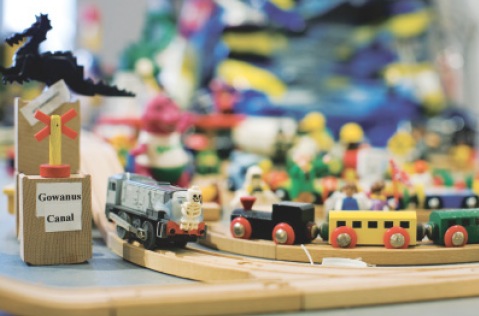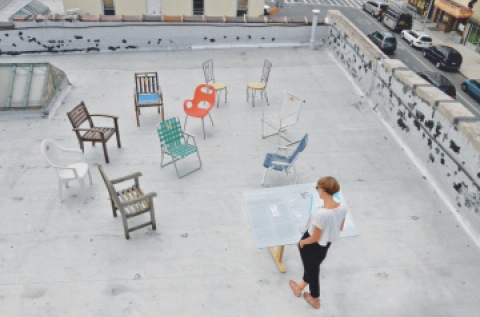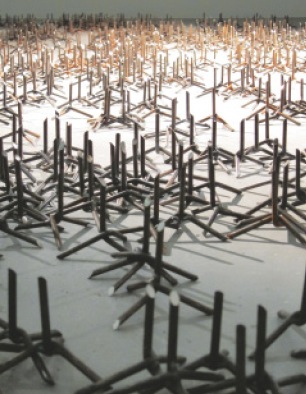
Detail of “No Sleep ‘til Brooklyn,” 2011, an installation by the People’s Art Collective at the Bogart Salon. Photo by Matthew C. Lange
At the center of the Bogart Salon, toys and trash make up a sprawling model of two very different allegorical places, the “Art Scene” and “Hedge Fund City,” connected by choo-choo trains. The model was supposedly devised by a clandestine group of art collectors from the wealthy suburbs of Westchester County, New York, and Fairfield County,Connecticut. They call themselves the People’s Art Collective.
In the “Art Scene” section of the model, we find many familiar characters from across Brooklyn’s artsy enclaves—toy figures of bearded men, a deejay, laptop users in a coffee shop, and giant rats along the Gowanus Canal. There’s a box wallpapered in the visage of an artists’ loft called Heartbreak Hotel. And a “Volcano of Youthful Passions” made of empty beer bottles, crushed cigarette packs, foam peanuts, and Mickey Mouse souvenirs, wrapped in tape and painted blue. Crowded and dirty, the “Art Scene” encapsulates an outsider’s perspective of our fair borough, a disdainful view that is more-or-less accurate.
On the opposite end, in bucolic “Hedge Fund City,” horses graze on green grass, piglets suckle their mama’s teats, a man humps a sheep, a mermaid splashes in a blue pond. Instead of a volatile volcano, the area is powered by a “Self Re-Generating Windmill of Wealth” made of Lego blocks. Catalogs for Williams-Sonoma, Coldwater Creek, and L.L. Bean fan out across the landscape. It’s a land of plenty, with ample space for its rich residents, a place not dissimilar to Westchester and Fairfield counties.
Taking on such aliases as Michelangelo, Leonardo, Donatello, and Splinter (characters from the Teenage Mutant Ninja Turtles), the members of the People’s Art Collective seem to have a nostalgic yearning for childhood.
And their toy model extends this idea. The whole thing is juvenile and reckless, which could also describe a lot of hedge fund managers.
THE PEOPLE’S ART COLLECTIVE, “NO SLEEP ‘TIL BROOKLYN”
The Bogart Salon, 56 Bogart St., through 10/17

Kristyna and Marek Milde’s “In Loving Memory,” 2011, installation at NURTURE Art. Photo by mildeart
Perhaps the cheapest piece of furniture that one can buy is the white plastic garden chair. It is ubiquitous on porches and in yards throughout the world, especially among folks with little disposable income. And, at a few dollars a pop, the chairs themselves are pretty much disposable. Artistic duo Kristyna and Marek Milde found one of these chairs on a Chelsea sidewalk and decided to put it in an installation.
“In Loving Memory” solved a practical problem for NURTUREart. The gallery had a huge roof deck but nowhere for people to sit, so the Mildes hit the streets of New York and brought back a clashing collection of ten discarded chairs, which they cleaned and restored to working order.
The chairs alone are a ramshackle and hideous bunch, but the artists have outfitted each one with a commemorative plaque—much like the plates affixed to park benches in dedication to deceased loved ones—that elevates them to objects of conceptual intrigue. There’s a ratty green lawn chair inscribed as “In Loving Commemoration of the Obsolete,” a rounded red chair honoring the “Awkward,” a lifeguard chair memorializing the “Washed-Out,” and, of course, a white plastic garden chair for the “Uncool.”
This project was meant to demonstrate how, with a little elbow grease, a piece of garbage can be resurrected as a perfectly usable throne. But it also shows that, by labeling an object as uncool, it suddenly becomes cool. Such is the power of irony.
KRISTYNA AND MAREK MILDE, “IN LOVING MEMORY”
NURTUREart Gallery, 910 Grand St., through 10/31

Detail of “Gregory Green: Through the Night Softly,” an installation at Regina Rex. Photo courtesy Regina Rex
During the display of “Through the Night Softly,” two unrelated events took place in New York that made Gregory Green’s installation seem almost prophetic: protesters occupied Wall Street for weeks on end and Palestine applied for state membership in the United Nations. What do these occurrences have to do with Green? His work explores empowerment of the little man over the powers that be.
Scattered across the gallery floor are 2,552 tire spikes made of slightly rusted steel. Any of the four-sided points of these spikes, which look like a malicious game of jacks, promises to puncture the sneaker of a gallery goer who does not watch his step. A painful proposition.
Green’s past sculptures have included a pipe bomb, a suitcase bomb, and a nuclear device—functional objects, the artist has claimed, minus the explosive material that could make them deadly. The tire spikes are tamer offshoots of these projects, all of which are meant to demonstrate that, without specialized training, any schmuck from Brooklyn (i.e., Green) could violently disrupt the day-to-day operations of society. In the case of the current installation, however, aesthetics also comes into play. Dispersed in an abstract pattern and gently lit under spotlights, the hand wrought spikes are as handsome as they are dangerous.
Which brings us back to Palestine’s application for statehood. A clearing around the prickly objects leads to a tiny flat-screen television. Here, in crisp documentary-style footage shot by Canadian filmmaker Jody Shapiro, we see Green standing at the head of the UN general assembly hall.
He wears a blue suit and wire-framed glasses and holds an open laptop in his hand. Reading from the computer, the middle-aged artist delivers a three-minute speech proclaiming sovereignty for the “New Free State of Caroline,” located in the Caroline Atoll, an uninhabited string of islets in the South Pacific. But no dignitaries are in attendance; Green is speaking to an empty room. Still, it’s thrilling to see a person stand up before the world and declare his independence.
GREGORY GREEN, “THROUGH THE NIGHT SOFTLY”
Regina Rex, 1717 Troutman St. #329, through 10/16
Leave a Reply